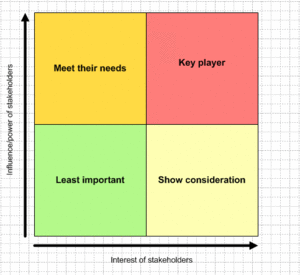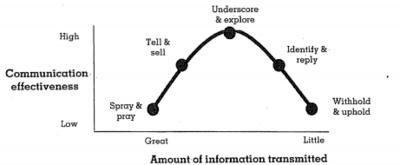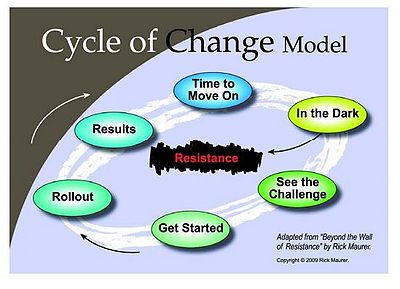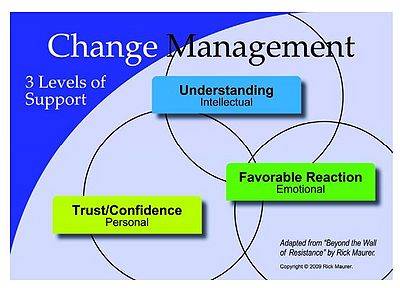Communication and Managing People in Change Projects
Developed by Arjun Abraham Punnen
Project managers have to be able to effectively manage projects with respect to time, scope and cost but a greater challenge is to manage the project team. Human behaviour is an important factor that determines the success and timely delivery of a project. Project Managers are faced with situations where changes to the scope of a project are introduced, for instance, requirements from clients change and these changes have to be included, even during the last stages of the project. A project in itself brings about change. There will always be, people for and against the change. Not everybody can be satisfied and therefore, managers need to have the ability to communicate effectively and lead people towards the goals of the project and minimize or avoid any form of conflicts and resistance from the employees.
Communication is critical in all changes within a project or an organisation and over sixty percent of change projects fail due to the lack of acceptance from the employees.[1] Effective communication reduces the uncertainty that is involved during change. Agile framework in project management allows the client to make changes to the requirements even at the final stages of a project and many organisations use this methodology.[2] Therefore without an effective approach to communicate change, many projects will fail. Clampitt’s five communication strategies will be discussed in detail and is an effective communication approach that can be used by project managers to create a shared sense of direction, establish priorities, reduce disorder and uncertainty and facilitate learning.[3] Based on stakeholder mapping, different communication strategies can be adopted depending on the power and influence of a stakeholder in the outcome of a project.[4] Resistance to change and conflicts from the employees, if not dealt with effectively, becomes a setback to the delivery of the project. Therefore managers should be able to identify sources of resistance from the employees and manage them effectively. Rick Maurer's Cycle of Change model and Three Levels of Support will be touched upon to identify the causes of resistance and ways to apply the model to minimise resistance is elaborated. This article focuses on empowering managers to communicate effectively and minimise resistance to change.
Contents |
Effective Communication
The Project Management Institute, PMI announced that two out of five projects do not meet their originally set goals and one out of five projects fail due to ineffective communication.[5] It is not sufficient for project managers to be good communicators but have to communicate in ways that the whole organization benefits from it. Successful projects are an outcome of effective communication methods adopted from the initial to the final stages of the project.
Stakeholder analysis identifies the power and influence that different stakeholders possess in any project. Based on this, project managers can easily prepare communication goals and select a strategy to communicate effectively with all the stakeholders.[3]
Stakeholder mapping
A stakeholder is any individual, group or organization that can affect, be affected by, or perceive itself to be affected by a programme. The first step is ‘stakeholder brainstorm’ which involves identifying all the stakeholders who have an interest or influence over the outcome of the change project. The second step involves assessing how much power and influence each stakeholder has. The third step involves assessing each stakeholder’s attitude towards the proposed change.
Influencing stakeholders to support the change
After laying out the different stakeholders on the stakeholder grid, managers should try to influence each of the stakeholders so that they move to the top right corner of the stakeholder grid. Firstly, stakeholders that have high power in the outcome of the project should be convinced to support the change. Then, managers could try to improve the stakeholders that have less power within the project but already are supportive of the change. If the first step of convincing powerful resistors does not work, managers may try to decrease their influence in the project by maybe reducing their decision powers. Managers should look to develop a strong team of supportive stakeholders who are willing to work together to support the change. Heraclitus of Ephesus, the greek philosopher said "Everything changes and nothing stands still".[6] An effective communication plan is one that considers all the changes throughout the project and makes sure that all the stakeholders are fully updated with the progress of the project.
Communication Channels
The following questions could be considered by a project manager to decide the communication plan during change in a project or organisation:
• What kind of communication is required? (Management Meetings, Team Meetings, Management Reporting)
• Who needs to be communicated with? (Stakeholder Mapping)
• How frequent is the communication required?
• What needs to be communicated? (Reports, Meeting minutes, Details or Summary)[5]
There are many channels for change leaders to communicate change. Information can be shared through emails, tweets, videoconferencing, texts, telephone calls, personal face-to-face communication through one-to-one, one-to-group or group-to-group methods. Clampitt, DeKoch and Cashman argue that sending emails to all employees regarding a major change could be an efficient way of communication but not the most effective way to ensure employee acceptance. An effective method to deal with resistance and convince employees could be face-to-face communication. The five communication strategies suggested by Clampitt, DeKoch and Cashman are as follows.
Clampitt’s five communication strategies
Spray and Pray: The managers shower employees with all kinds of information both relevant and irrelevant and hope they will feel informed and have access to all the information they need. Managers hope that employees can see the difference between important and general information. This communication strategy gives employees a chance to take part in improving the decision making.[3]
Tell and Sell: The managers are not allowed to give all kinds of information to the employees. Information exchanged is very limited and related to the change. The managers tell the employees first about the core issues and then try to sell them the wisdom of their approach to managing them.[3]
Underscore and Explore: Employees have opportunities to share their ideas and managers consider employees’ ideas to improve the change process. Here the managers focus on few clear messages related to the change, same as “tell & sell” approach. But here the managers give the employees the freedom they need to explore the implications of these issues. Those who adopt this approach are concerned not only with developing a few core messages but also listen for misunderstandings and unrecognised obstacles.[3]
Identify and Reply: The main focus is on employees’ problems. It requires a lot of listening in order to identify and respond to these issues. In this type of communication, too much sharing or exchange of information is not possible, because the process is not fully in control of the managers. There might be some employees who are not willing to ask for information or managers don’t feel it is necessary to share. [3]
Withhold and uphold: The managers withhold information until it is necessary and as long as possible. Secrecy and control are the keywords in this approach. Some of those who adopt this strategy assume that information is power and they are reluctant to share it with anyone. Spray & pray is the opposite of this approach. There is lack of open and constructive communication.[3]
Resistance to Change
Well known Change Management Consultant, Rick Maurer suggests that a major reason for changes to fail is resistance from people.[7] Change leaders assume that if information is shared and explained to the employees in a detailed way, then most of them would accept the change. But the basic issue that leaders neglect is that people resist due to many other reasons and not only due to shortage of information. The cycle of change model can be applied to understand the reasons for people to resist change once it is known where in the cycle the leader is and where the employees are. Apart from that, it can helps to understand that no change lasts forever, predict the consequences of using a particular approach to change, monitor progress and take corrective actions.
Cycle of Change
Rick Maurer's Cycle of Change model shows that change takes place in cycles and there are six stages as shown in FigureX.x.[7] They are discussed below in detail.
In the Dark: At this stage, the employees do not have much information about the need to change. Since they do not find the need to do things differently, the probability of the employees getting on board with the leader is very low. Without sufficient information about the need to change, the leader's change plan is an obstacle to their daily work.
See the Challenge: This is the most important stage of a change, also referred to as the "aha moment" by Rick Maurer. Here, the work on the change is intiated when the key stakeholders identify the same challenges and opportunities as the leader. Employees become prepared to act on the change at this stage as they understand the need for change.
Get Started: This is when managers define goals, prepare time schedules and deadlines, construct a vision, involve people in the change process and measures of success. Most leaders are known to skip the first two steps forgetting that the employees need to be helped out from the dark and identify the same vision of the leader.
Roll-out: This phase is where the changes are implemented within the project where the analysis is completed and the employees are trained and new processes are established. At this stage, the leader declares that the new system is effective but there is no assurance that people will adopt the changed practices. Therefore, managers have to be aware not to make the mistake of declaring victory at this phase but to follow-up on the results of the change.
Results: It is at this phase that the change is adopted by the employees and becomes part of the daily working culture. It is no more seen as a change and the results can be either short-lived or last a long time depending on various dynamic factors such as market demographics, degree of competition, new technology and others.
Time To Move On: There comes a time when even the finest projects dies down and a need for change comes into existence again. Managers and organisation should ensure that they do not overlook indications that the current status quo has to be changed to something new and that it is time for another change.
It is seen often that change managers jump directly to the third or fourth stages and this creates a lot of resistance from the employees. Engagement of all stakeholders from the first stage is extremely important. Resistance to change is a reaction to the way a change is being led.[7] Employees are never in the mindset to resist everything that is proposed by the manager. Resistance could be considered as a feedback to something, therefore the reasons for the lack of support from the employees need to be understood which makes it simpler to know which areas need to targetted in order to build support. Rick Maurer points out that there are three levels of resistance.
Three levels of Resistance
1. Level 1 - I don't get it
This level of resistance is shown over the information provided to the employees regarding the change. It could be a situation where sufficient information was not shared, or there are conflicts over the understanding of the information, or key data is not shared with the employees, or maybe the employees do not understand the information that is shared with them.
2. Level 2 - I don't like it
This type of resistance from the employees is at an emotional level mainly because of fear. Employees can be worried about losing their status, control and also their jobs. This causes a rise in blood pressure, pulse and adrenaline and people are concerned about their survival. This enforces a situation where the employees are concerned more about themselves and so tend to ignore most of the information regarding the change. Hence, it is a challenge to communicate effectively when employees display level 2 resistance. They expect managers to give them answers to level 2 concerns while maybe asking level 1 questions as most organisations do not expect employees to react on an emotional level.
3. Level 3: - I don't like you
Here is a situation where the employees do not have confidence in the leader's capability to manage the change project. This is one of the factors that is sometimes ignored and leads to many change initiatives failing. The employees may trust the leader but probably do not trust the organisation or the people that the leader represents. It could be due to personal relationships of the past or the employees do not believe that the leader can take the right decisions.
The Three Levels of Support model can be used by change leaders to develop ways to minimise resistance based on their level.
Three levels of Support
1. Level 1 - Make Your Case
The need for the change should be explained clearly to the employees. Why the change must be carried out should be known to the employees before informing them on how to implement the change. Make it simple for employees to understand the change. Complex presentations and complicated statistics can confuse employees and should be avoided wherever possible. Share information through different mediums. Some people respond better to visual representations, some to one-on-one conversations or calls. Many forms of communication channels increase the possibility of better understanding.
2. Level 2 - Remove as much of the Fear as You Can and Increase the Excitement about What's Positive about the Change
Employees have to see that the change will help them in some way. Therefore the opportunities for them should be stressed upon. People can be engaged during the planning phases of the change project. This will increase their support if they are included in the change right from the start. A manager should be honest with the employees. It makes the manager trustworthy and also they deserve to know all the impacts of the change, for instance, if it will affect them in a negative manner.
3. Level 3 - Rebuild Damaged Relationships and Tend to Neglected Relationships
Managers should work on building better relationships with employees in case they have strained relations which may have been a consequence of something that may have happened during the past. All promises must be kept in order to build trust among the employees. The manager need not address to every demand from the employees but could consider some of the ideas or suggestions that are brought out. There could be situations where the manager has made a mistake.[8]
Conclusion
Communication in the present world is effortless than ever before. Technology allows people in different parts of the world and different cultures to connect and work together. It is important that change managers study and analyse the change project and identify critical issues before defining a communication strategy. Managers must also understand the reasons for people to resist change and then develop ways to reduce or avoid resistance. Change can cause employees to get out of their comfort zone and could be demanding for some, therefore managers have to listen to them and even have to provide emotional support to their employees.
References
- ↑ The Parker Avery Group, Retail consulting and industry thought leadership; Change management Communication, Laying the Groundwork for a successful Communication Strategy
- ↑ https://en.wikipedia.org/wiki/Agile_management
- ↑ 3.0 3.1 3.2 3.3 3.4 3.5 3.6 John Hayes, 2004; The theory and practice of change management
- ↑ https://en.wikipedia.org/wiki/Stakeholder_analysis
- ↑ 5.0 5.1 http://www.pmi.org/-/media/pmi/documents/public/pdf/learning/thought-leadership/pulse/the-essential-role-of-communications.pdf
- ↑ https://en.wikipedia.org/wiki/Heraclitus
- ↑ 7.0 7.1 7.2 http://www.rickmaurer.com/wp/wp-content/uploads/2010/12/Intro-CWOM-tm-final.pdf
- ↑ Porter, M.E. (1985) Competitive Advantage: Creating and Sustaining Superior Performance, Simon & Schuster
Annotated Bibliography
1. John Hayes, 2004; The theory and practice of change management
John Hayes' best-selling textbook provides you with the skills you will need as a future manager or leader to identify the necessity for change and ensure its successful implementation. Its hands-on approach includes a number of 'change tools' that you can apply to various change scenarios, exercises which invite you to reflect on your experience of change in everyday life, and a host of case studies and examples based on real-life organizations worldwide. These practical features are underpinned by a theoretical framework presenting change as a flexible yet controlled sequence of activities.
2. Beyond the Wall of Resistance: Why 70% of All Changes Still Fail--and What You Can Do About It
Companies that don't change die. Change is everyday corporate life - plans for cost cutting, restructuring, new technology, quality improvement, new products/services are ongoing challenges in companies of all sizes. Resistance is a huge roadblock. This real-world guide shows frustrated managers how to build support for change and stay competitive. Practical approaches with new case studies show how to deal with resistance in a way that retains strong working relationships while achieving successful change.



